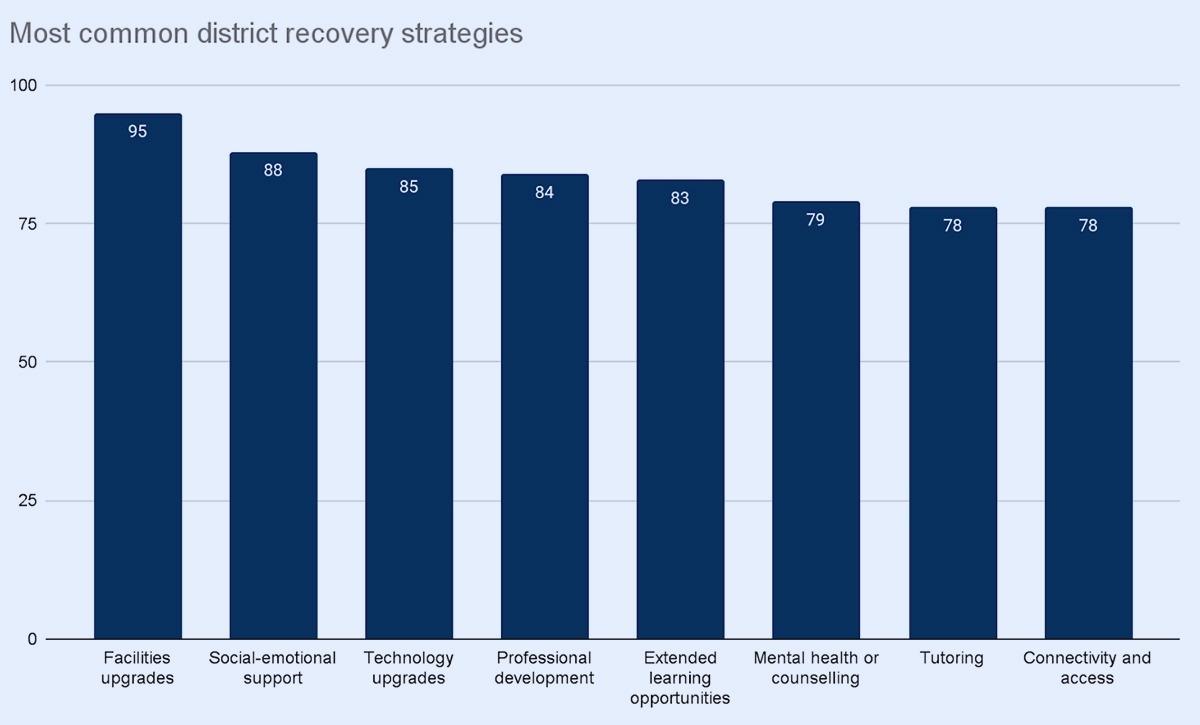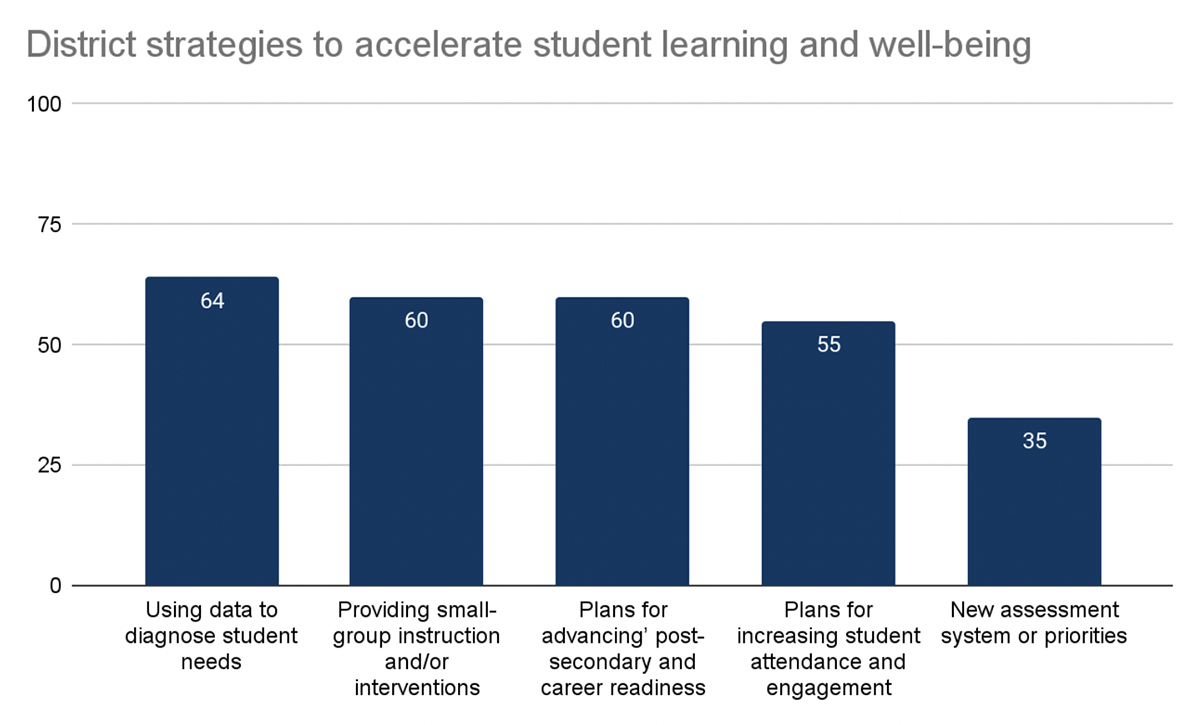Building Upgrades, SEL: 100 Large & Urban Districts Plan Their Pandemic Recovery
New review of ESSER spending plans shows districts favor facilities improvements, student & teacher supports; investments in staff, parents less clear

Get stories like these delivered straight to your inbox. Sign up for The 74 Newsletter
Since 2020, the federal government has sent $189.5 billion to schools for COVID-19 recovery efforts. But how is it being spent? The Center on Reinventing Public Education is helping to answer that question with a new database that details the post-COVID recovery strategies of 100 large U.S. districts — all of which have been fueled by federal Elementary and Secondary Schools Emergency Relief (ESSER) money.
The analysis is based on CRPE’s year-long review of the districts’ federally mandated spending plans for the relief money, their proposed budgets and their publicly posted recovery spending strategies in 2021-22. The review is limited to publicly available information.
These strategies preview how the nation’s largest school districts are thinking about postpandemic recovery and what the return to a new normal is likely to entail. The release is part of CRPE’s new searchable, downloadable pandemic data tracking site, which makes its two-plus years of pandemic-era district data tracking and analysis available to the public.
The work builds on CRPE’s new “State of the American Student” report, which pushes states and districts to define measurable goals for pandemic recovery, or risk graduating a generation of students under-equipped for college or careers. The data is a call to action for districts and states to immediately use their federal dollars to ensure every student in the COVID generation makes a full recovery.
Highlights from the review include:
Large and urban districts almost universally prioritize facilities improvements, and most plan to invest in broad student and teacher supports
Eight recovery strategies clearly stood out in district plans for ESSER spending. Almost all districts plan to upgrade facilities (95). Social-emotional supports are next most common (88), followed by technology (85), professional development (84), extended learning opportunities (83), mental health (79), tutoring (79) and internet connectivity and access (78).

Districts plan to pursue some specific student-centered recovery strategies
A moderate number of districts detail specific strategies to accelerate student learning and well-being. Just two-thirds mention using evidence-based strategies involving data (64) or small-group interventions (60) to catch up students academically. Similarly, about two-thirds (60) are considering investments to strengthen career and postsecondary pathways. Around half of districts plan to re-engage students or work to increase enrollment (52), or invest in new testing systems (35) to better capture academic or social-emotional data.

But investments in staff and parents are less clear
While most districts plan to provide professional development for teachers, far fewer detail specific recruitment strategies like strengthening teacher pipeline programs or university partnerships (37) or providing more mentoring or coaching (26). Parent engagement was among the least frequently cited strategies, with a small portion of districts committing to improving communications with families (20) or providing new leadership opportunities to parents or community stakeholders (15).

District plans vary widely in detail shared and breadth of strategies
The clarity districts offer on their spending plans varies widely. Some began sharing recovery ideas and inviting stakeholders to participate in planning sessions as early as last spring. Others have not yet communicated full plans or invited public feedback.
A few districts, including Buffalo Public Schools in New York and the Montgomery County School District in Maryland, stand out for sharing detailed plans that profile a range of new supports for students, staff and parents.
Buffalo will provide an extended school day and school year; small-group instruction; and new programs for students who have special needs or are multilingual and/or Native American. The district will use data to diagnose student needs and hire new intervention staff. It plans to run an engagement program where parent leaders will support other families in their schools and attend monthly school-based management team meetings. The district will offer professional development on STEM, Advanced Placement and anti-racism instruction and plans to send staff to conferences and workshops. Buffalo also offers its staff members self-paced, virtual professional development.
Montgomery County will use data to select students for Saturday school, tutoring and enrichment programs. It is also expanding sports and after-school enrichment programs to re-engage students. Montgomery County plans to train staff in tutoring strategies, student well-being support and how to target assistance to vulnerable students, such as English learners and children with special needs. The district has also designed a professional learning cohort that specifically targets second-year teachers.
Recovery spending needs to happen in earnest, starting now
While the data on students’ remarkable learning loss and mental health needs piles up, the majority of districts have spent just a fraction of stimulus funds to date. This may have made good sense last school year; districts were caught up in a series of disruptions fueled by virus surges and labor shortages, and they needed time to ground their ESSER spending plans in stakeholder input and strategic plans. Fortunately, the start of the 2022-23 school year is proving to be the least disruptive since the pandemic started. Now is the time for districts to make good on their plans, and clearly communicate how they will restore and advance learning environments for students and work environments for adults.
Our review finds that large and urban districts are committing most clearly to one-time investments in infrastructure but are less precise about recovery strategies to meet the postpandemic needs of students, staff and families. While stimulus funds are a one-time infusion, districts still have the opportunity to make deep, multi-year investments in services and programs that could better support staff and students. Improving learning and working conditions is just as important as facility or technology upgrades — arguably more so, given rampant reports of teacher burnout and enrollment declines of 1.3 million students between 2020 and 2022. It is imperative that districts pair long-term investments in their people and systems alongside short-term investments in infrastructure.
It is also worth noting that plans are also just that — plans — until they are put into motion. Districts need more clarity on the Education Department’s revised ESSER deadlines in order to execute spending strategies. Either way, given that stimulus funds expire as early as 2024, it is imperative that districts begin to thoughtfully spend them down now. And with few parents aware of stimulus funding at all, districts also need to clearly communicate their spending plans and reach back out to stakeholders for suggestions.
Get stories like these delivered straight to your inbox. Sign up for The 74 Newsletter

;)
